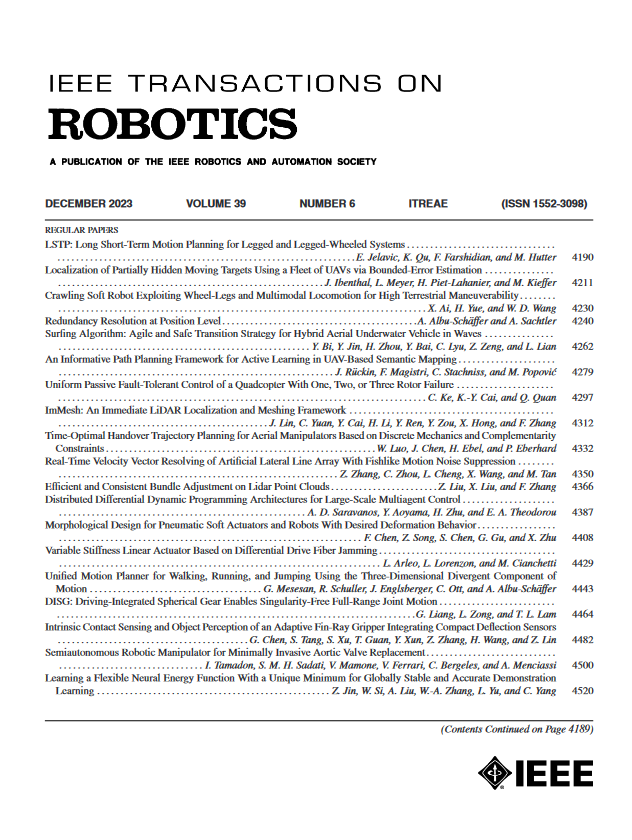RoTipBot: Robotic Handling of Thin and Flexible Objects Using Rotatable Tactile Sensors
IF 9.4
1区 计算机科学
Q1 ROBOTICS
引用次数: 0
Abstract
This article introduces RoTipBot, a novel robotic system for handling thin, flexible objects. Different from previous works that are limited to singulating them using suction cups or soft grippers, RoTipBot can count multiple layers and then grasp them simultaneously in a single grasp closure. Specifically, we first develop a vision-based tactile sensor named RoTip that can rotate and sense contact information around its tip. Equipped with two RoTip sensors, RoTipBot rolls and feeds multiple layers of thin, flexible objects into the centre between its fingers, enabling effective grasping. Moreover, we design a tactile-based grasping strategy that uses RoTip’s sensing ability to ensure both fingers maintain secure contact with the object while accurately counting the number of fed objects. Extensive experiments demonstrate the efficacy of the RoTip sensor and the RoTipBot approach. The results show that RoTipBot not only achieves a higher success rate but also grasps and counts multiple layers simultaneously—capabilities not possible with previous methods. Furthermore, RoTipBot operates up to three times faster than state-of-the-art methods. The success of RoTipBot paves the way for future research in object manipulation using mobilized tactile sensors.RoTipBot:使用可旋转触觉传感器处理薄而柔韧物体的机器人
这篇文章介绍了RoTipBot,一种新颖的机器人系统,用于处理薄的、柔性的物体。与以往仅限于使用吸盘或软抓取器进行单次抓取不同,RoTipBot可以对多层进行计数,然后在单个抓取闭合中同时抓取它们。具体来说,我们首先开发了一种名为RoTip的基于视觉的触觉传感器,它可以旋转并感知其尖端周围的接触信息。RoTipBot配备了两个RoTip传感器,它可以滚动并将多层薄而灵活的物体送入手指之间的中心,从而实现有效的抓取。此外,我们设计了一种基于触觉的抓取策略,利用RoTip的感应能力,确保两个手指与物体保持安全接触,同时准确地计算被喂物体的数量。大量的实验证明了RoTip传感器和RoTipBot方法的有效性。结果表明,RoTipBot不仅获得了更高的成功率,而且能够同时掌握和计数多个层,这是以前的方法无法实现的能力。此外,RoTipBot的运行速度比最先进的方法快三倍。RoTipBot的成功为未来使用移动触觉传感器进行物体操纵的研究铺平了道路。
本文章由计算机程序翻译,如有差异,请以英文原文为准。
求助全文
约1分钟内获得全文
求助全文
来源期刊

IEEE Transactions on Robotics
工程技术-机器人学
CiteScore
14.90
自引率
5.10%
发文量
259
审稿时长
6.0 months
期刊介绍:
The IEEE Transactions on Robotics (T-RO) is dedicated to publishing fundamental papers covering all facets of robotics, drawing on interdisciplinary approaches from computer science, control systems, electrical engineering, mathematics, mechanical engineering, and beyond. From industrial applications to service and personal assistants, surgical operations to space, underwater, and remote exploration, robots and intelligent machines play pivotal roles across various domains, including entertainment, safety, search and rescue, military applications, agriculture, and intelligent vehicles.
Special emphasis is placed on intelligent machines and systems designed for unstructured environments, where a significant portion of the environment remains unknown and beyond direct sensing or control.
 求助内容:
求助内容: 应助结果提醒方式:
应助结果提醒方式:


